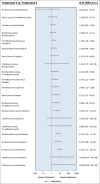The use of chemotherapeutic agents as prophylaxis for recurrent urinary tract infection in healthy nonpregnant women: A network meta-analysis
- PMID: 31000921
- PMCID: PMC6458811
- DOI: 10.4103/iju.IJU_378_18
The use of chemotherapeutic agents as prophylaxis for recurrent urinary tract infection in healthy nonpregnant women: A network meta-analysis
Abstract
Introduction: The aim of this systematic review is to compare chemotherapeutic agents commonly used in treating recurrent urinary infection in nonpregnant women by their efficacy, tolerability, adverse effects, and cost employing network meta-analysis.
Materials and methods: We used three online databases, i.e., PubMed, ScienceDirect, and Cochrane Central Registry of Clinical Trials. Randomized controlled trials (RCTs) on the use of prophylactic chemotherapeutic agents used in treating nonpregnant women with recurrent urinary tract infections (RUTIs) published between 2002 and 2016 were selected. Only published papers in English were assessed for study quality, and meta-analyses were performed using fixed-effects model with NetMetaXL.
Results: Six RCTs fulfilled the criteria. When all three variables, i.e., efficacy, adverse effects and cost were considered, nitrofurantoin 50 mg once daily for 6 months appears to rank high for prophylaxis against RUTI. When efficacy was the only factor, fosfomycin had the highest superiority compared to D-mannose, nitrofurantoin, estriol, trimethoprim-sulfamethoxazole, and cranberry juice, respectively. However, fosfomycin was also ranked highest by adverse events. When cost alone is considered, nitrofurantoin appeared the most cost-effective agent while placed third for efficacy alone.
Conclusion: Selecting appropriate chemotherapeutic agents for RUTI will need to factor in effectiveness, adverse effects, and cost. While it is difficult to select an ideal drug, evaluation using network analysis may guide choice of medication for best practice.
Conflict of interest statement
Conflict of Interest: There are no conflicts of interest.[25]
Figures






Similar articles
-
Role of D-Mannose in the Prevention of Recurrent Uncomplicated Cystitis: State of the Art and Future Perspectives.Antibiotics (Basel). 2021 Apr 1;10(4):373. doi: 10.3390/antibiotics10040373. Antibiotics (Basel). 2021. PMID: 33915821 Free PMC article. Review.
-
A cost-minimization analysis of treatment options for postmenopausal women with dysuria.Am J Obstet Gynecol. 2019 Nov;221(5):505.e1-505.e7. doi: 10.1016/j.ajog.2019.04.031. Epub 2019 May 2. Am J Obstet Gynecol. 2019. PMID: 31055032
-
Prevention of recurrent urinary tract infections.Minerva Urol Nefrol. 2013 Mar;65(1):9-20. Minerva Urol Nefrol. 2013. PMID: 23538307 Review.
-
Efficacy of vaccination with StroVac for recurrent urinary tract infections in women: a comparative single-centre study.Int Urol Nephrol. 2021 Nov;53(11):2267-2272. doi: 10.1007/s11255-021-02987-4. Epub 2021 Sep 9. Int Urol Nephrol. 2021. PMID: 34499326
-
The Clinical Efficacy of Nitrofurantoin for Treating Uncomplicated Urinary Tract Infection in Adults: A Systematic Review of Randomized Control Trials.Urol Int. 2021;105(7-8):531-540. doi: 10.1159/000512582. Epub 2021 Feb 3. Urol Int. 2021. PMID: 33535221
Cited by
-
Bacterial Flora and Treatment Strategies in Women With Escherichia coli Urinary Tract Infections.Cureus. 2024 Mar 20;16(3):e56552. doi: 10.7759/cureus.56552. eCollection 2024 Mar. Cureus. 2024. PMID: 38646229 Free PMC article.
-
Strategies for older people living in care homes to prevent urinary tract infection: the StOP UTI realist synthesis.Health Technol Assess. 2024 Oct;28(68):1-139. doi: 10.3310/DADT3410. Health Technol Assess. 2024. PMID: 39432412 Free PMC article. Review.
-
Relationship between the Presence of Human Papillomavirus in the Female Urethra and Recurrent Urinary Tract Infections.J Clin Med. 2024 Sep 9;13(17):5329. doi: 10.3390/jcm13175329. J Clin Med. 2024. PMID: 39274542 Free PMC article.
-
Summary of guidelines from the Polish Urological Association, Polish Society of Gynaecologists and Obstetricians, and Polish Society of Family Medicine on the diagnosis, therapy, and management of community-acquired lower urinary tract infections.Cent European J Urol. 2024;77(3):520-527. doi: 10.5173/ceju.2024.01.Guid. Epub 2024 Oct 29. Cent European J Urol. 2024. PMID: 40115487 Free PMC article.
References
-
- Glass R, Curtis M, Overholt S, Hopkins M. Glass’ Office Gynecology. Vol. 6. Philadelphia: Lippincott Williams & Wilkins; 2006. Urogynecology and pelvic floor dysfunction; pp. 435–9.
-
- Foxman B, Barlow R, D'Arcy H, Gillespie B, Sobel JD. Urinary tract infection: Self-reported incidence and associated costs. Ann Epidemiol. 2000;10:509–15. - PubMed
-
- Hooton TM. Pathogenesis of urinary tract infections: An update. J Antimicrob Chemother. 2000;46(Suppl 1):1–7. - PubMed
-
- Hooton TM. Recurrent urinary tract infection in women. Int J Antimicrob Agents. 2001;17:259–68. - PubMed

